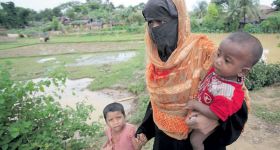- News
LaterMost ReadDistinctiveRohingya News Agency: Myanmar: Tens of thousands of Rohingya people - who remain deprived of a nationality - displaced by “clearance operations” amid reports of unlawful killings, indiscriminate firing on civilians, ...
- Issues
Most ReadDistinctive
- Books
- Documents
LaterMost Read
- Figures
- Entries
Most ReadDistinctiveShwe Maung, Former Myanmar MP November 15, 2016 Myanmar Security Forces are enjoying to kill Rohingyas including children, rape women and torching and destruction Rohingya houses and villages after the " October ...
- Arakan
Who Are the Rohingya and Why Are They Fleeing Myanmar?
Saturday | 16/05/2015 - 09:33 AM
Indonesian rescue team members in Lhoksukon distribute food to migrants on May 11 inside a shelter after they were rescued from boats. RONI BINTANG/REUTERS
BY LUCY WESTCOTT - News Week
5/11/15
FILED UNDER: World, Rohingya, Rohingya Muslims, Refugees, Indonesia, Malaysia, Boat Migrants
Around 1,600 refugees from Myanmar and Bangladesh were rescued off the coast of Indonesia on Sunday and detained in Malaysia on Monday.
Malaysian officials said Monday that 1,081 Bangladeshi and Rohingya refugees landed on the country’s Langkawi Island. On Sunday, 600 “sad, tired and distressed” migrants were stranded off the coast of the Indonesian province of Aceh. On Monday, another 400 were found aboard a ship, the BBC reports.
Hundreds of those people are believed to be Rohingya, the ethnic Muslim minority in Myanmar who for decades have faced discrimination and persecution in the majority-Buddhist country. The government of Myanmar considers the country’s approximately 1.33 million Rohingya illegal settlers, and the United Nations classifies them as one of the most persecuted refugee groups in the world.
Try Newsweek: subscription offers
On her visit to the country earlier this year, Yanghee Lee, the U.N. special rapporteur on human rights in Myanmar, saw “no improvement” in the way the Rohingya were being treated.
“The conditions in Muslim [internally displaced person] camps are abysmal, and I received heartbreaking testimonies from Rohingya people telling me they had only two options: stay and die or leave by boat,” she said in a statement.
Malaysia and Indonesia are both majority-Muslim countries.
An Indonesian policeman distributes used clothes to migrants believed to be Rohingya inside a shelter in Lhoksukon on May 11. RONI BINTANG/REUTERS
Between January and March this year, around 25,000 Rohingya and Bangladeshis boarded boats run by smugglers, twice as many as in the same period in 2014, according to the U.N. refugee agency. Thailand is the usual destination for the migrant boats, but a recent crackdown on human trafficking means the smugglers have had to set their sights elsewhere, Reuters reports.
Between 1826 and 1948, the Rohingya were brought from India by the British during their colonial rule to work in Myanmar. Since then, their origin has been disputed, with some believing they hail from Bangladesh and others saying they came from Rakhine state in southeastern Myanmar.
Myanmar’s president, Thein Sein, denies there have been human rights abuses against the Rohingya, calling such reports “pure fabrication.” He also denies that the Rohingya are a people and refers to them as “Bengalis.” Calling the Rohingya “Bengali” is “a discriminatory, xenophobic way of erroneously implying that Rohingya are illegal immigrants from Bangladesh,” says the U.S. Campaign for Burma, a Washington-based nonprofit. Sein has called on the U.N. to facilitate the deportation of the Rohingya to other countries, but the U.N. rejected the proposal.
Last year, Myanmar unveiled a controversial plan offering Rohingya citizenship if they changed their ethnicity to Bangladeshi in origin. For the Rohingya, calling themselves “Bengali” implies they are illegally in the country, which most of them reject.
------------
In 1982, the Rohingya were stripped of their citizenship by the government of Myanmar, then known as Burma. The Burma Citizenship Law also restricted their access to education, services and freedom of movement, and allowed property to be taken arbitrarily. More than 140,000 Rohingya live in internally displaced persons camps around Sittwe, the capital of Rakhine state, in southwest Myanmar, where they are entirely dependent on international assistance, Human Rights Watch said in 2014. More than 200,000 Rohingya refugees live in Bangladesh, according to Refugees International. They are effectively stateless.
Advocates fear violence and discrimination against the Rohingya is escalating, fueling a surge in treacherous boat journeys. Last year, more than 40 Rohingya were massacred in the village of Du Chee Yar Tan by local men, the U.N. confirmed. Among the findings were 10 severed heads in a water tank, including those of children.
Earlier this month, dozens of bodies were discovered in smugglers’ camps in Thailand. Many of the victims were believed to be Rohingya.
التعليـــقات
Comments published does not reflect the opinion of the agency, but reflect the opinion of their owners

New Agency
Articles
Books
Mailing List
Search
















































































 Report: The Human Rights of Stateless Rohingya in Thailand
Report: The Human Rights of Stateless Rohingya in Thailand

